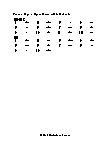Operations with Radicals Worksheets
How to Perform Math Operations with Radicals - Mathematical operations with radical or square root symbols are known as the radical expressions and can be easily identified with the obvious radical sign (√). Remember that the exponents tell us to multiply the given number a certain number of times. For instance, 62 shows to multiply the integer 6 with itself two times. 62 = 6. 6 = 36. However, the radicals or the roots are inverses of the exponentiation. That means they work backward from 36 to its square roots √36 = 6 Adding And Subtracting The Radical Expressions - For adding the radicals, the number under the radical sign, radicand should be the same for each radical expression. The general form of the equation would be: a√b +c√b = (a + c) √b. Putting in some values: √3+ 2√3 = 3√3. The subtraction of the radical follows the same rule as the addition. Consider an example below a√b - c√b = (a – c) √b Putting in some values: 3√3 - 2√3 = √3. Multiplying The Radical Expressions - In multiplication, we only have to multiply the numbers or values present under the radical sign. √a. √b = √a. b. An example with real numbers would be: √3 . √2 = √6
-
Independent Practice 1
Perform the indicated operations and simplify the answers. The answers can be found below.
View worksheet -
Independent Practice 2
When the radicals are same, simply add the number in front of the radicals.
View worksheet -
Homework Worksheet
Operations with Radicals problems for students to work on at home. Example problems are provided and explained.
View worksheet
A Fun Thought
I bet you did not know that Pi may not be normal. No one has yet proved that is not normal, so most people generally assume that it is.







